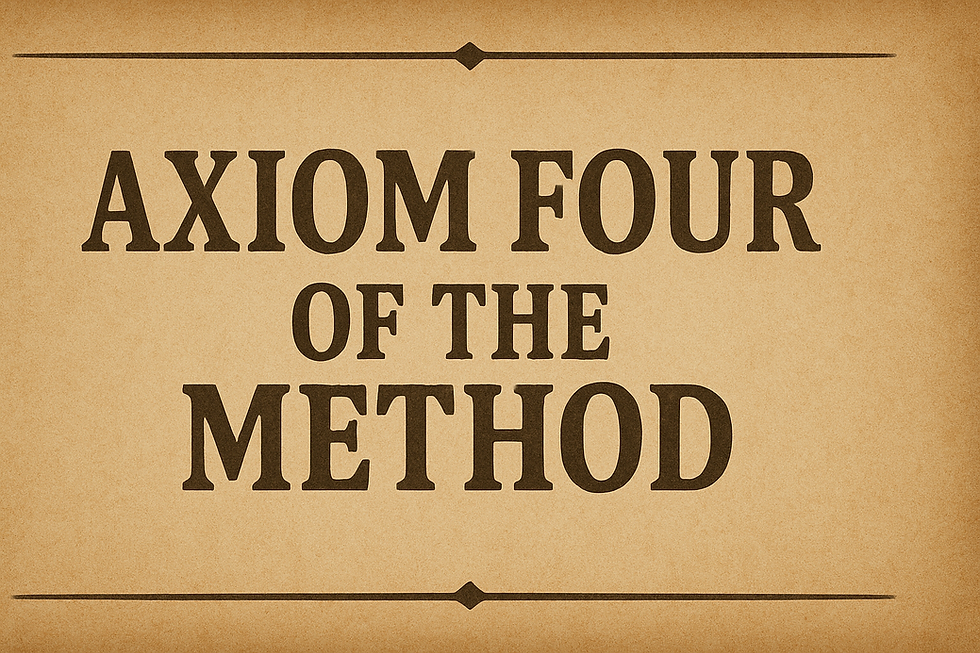Axiom Four of the Raymond Method: If You Can Find a Way that a Seemingly Ambiguous Move Will Lead to Your harm, Assume That This Is the Likely Intent—Until Proven Otherwise
- john raymond
- Jul 19
- 3 min read

I. Strategic Function of Axiom Four
Axiom Four closes the gap between known enemy intent and uncertain tactical ambiguity. In asymmetric warfare, many enemy actions are not obviously harmful. They are murky, deniable, symbolic, or incomplete.
Axiom Four says:
You must interrogate each ambiguous move for plausible pathways to harm. If any exist, treat the move as hostile—unless the threat collapses under scrutiny.
This is not paranoia. It is minimum viable defense. It ensures that ambiguous behavior by a proven enemy is treated with the seriousness it might deserve—before the damage is done.
II. Why It’s Necessary
Enemies don’t always strike with clarity. Some of their most effective moves are veiled in:
Symbolism
Delay
Bureaucracy
Personal drama
Public theater
This creates analytical paralysis. Western institutions, in particular, freeze when the signal isn't loud. They wait for damage before reacting. Axiom Four removes that lag:
When you see an ambiguous move by a known hostile actor, test for the worst plausible function. If you can trace it, you must model it as the intended outcome.
Until proven otherwise, the ambiguity is assumed to be part of the camouflage.
III. Relationship to Axiom Three
Axiom Three commands: Treat all moves by known enemies as attempts to hurt you.
Axiom Four sharpens that command in foggier terrain:
Even when you’re not sure what the move is yet, search for harm. If harm is plausible, presume it’s being pursued—unless proven structurally incoherent.
This allows for rigorous caution without slipping into conspiracism. The move isn’t condemned emotionally—it is evaluated functionally.
IV. Scientific and Game Theoretic Basis
Axiom Four is the practical expansion of minimax under conditions of partial information.
In traditional minimax, all game states are visible.
But in real-world asymmetric war, the “board” is fogged.
So you apply adversarial modeling under uncertainty.
This means:
When a proven enemy acts, and you do not yet see how it helps them, you must test every plausible line of play to see if it hurts you.
If any coherent endgame appears that would benefit their strategic goals, you must act as if that’s the plan, until disconfirmation arrives.
This is a disciplined way of saying:
Don’t assume ambiguity means innocence. Assume ambiguity is a screen—until you prove it’s empty.
V. Case Study: The Trump–Musk Split
In the aftermath of Ukraine’s Operation Spiderweb—an undeniable Ukrainian win—Trump and Musk appeared to have a public falling out. The media fixated on it. Speculation swirled: Was this a fracture in the alliance of tech-fascist enablers? Was it real? Was it staged?
Applying the Raymond Method:
Axiom One: Neither Trump nor Musk are to be trusted.
Axiom Two: Both are known enemies of Western cohesion.
Axiom Three: Their actions are presumed harmful until proven otherwise.
Axiom Four: The split is ambiguous—so interrogate it.
The question became: Can this rift—whether real or staged—be used to harm Ukraine, NATO, or democratic resolve?
I mapped every plausible outcome:
Could it divide the MAGA base?
Could it give one of them cover for a flanking move?
Could it serve as narrative bait to trap liberal media?
Could it distract or soften criticism of one side by “splitting” the enemy front?
Conclusion: No coherent asymmetric gain emerged. No functional outcome could be traced to sabotage of Ukraine or strategic Western objectives. The rift, while loud, lacked shape.
Final determination: ambiguous but structurally benign. Discarded from threat modeling.
And I was right. The rift was always meaningless.
The Raymond Method allowed me to identify it as noise—and not part of the asymmetric war they are waging against us for Putin’s benefit.
VI. Strategic Advantages of Axiom Four
Clarity Under Fog: You can act confidently even when the move’s intent is unclear.
Prevents Strategic Surprise: You’re not caught off-guard when ambiguous moves turn into real threats—because you’re already modeling them as such.
Avoids Overreaction: You don’t automatically treat every ambiguous gesture as a crisis. Only those with a plausible path to harm receive escalation.
Eliminates Narrative Drift: You don’t get seduced by soap opera or PR drama. The only question is: What harm could this cause?
VII. What Axiom Four Prevents
Slow recognition of asymmetric camouflage
False relief when enemy moves look “off-brand” or inconsistent
Emotional reattachment to hostile figures who appear to “waver”
Mindless Conspiracism
VIII. Conclusion: Ambiguity Is a Weapon
In asymmetric warfare, ambiguity is not a neutral state. It is often the precondition for a strike.
Axiom Four is how you survive long enough to see the true shape of the enemy's play. If you can imagine the harm, you prepare for it—until the threat collapses under logical pressure.
This is how the Raymond Method sees through smoke, propaganda, and shadowplay. Not every ambiguous move is war. But in asymmetric conflict, every move is a test. And Axiom Four ensures you never fail it.






Comments